Jorge
Luiz Abreu da Silva
|
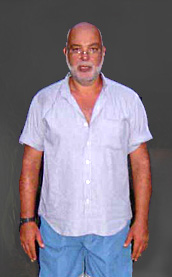 |

Jorge
Luiz Abreu da Silva
|
 |
|
ON:
Why did you star to cultivate orchids? Which was the magic moment of attraction
?
Ten years ago, I got a cutting scion from a friend who worked with me. Until then, I didn't know about orchids nor was interested in them. This friend brought to the annual orchid show at the Modern Art Museum - MAM, in 1996, where I stayed astonished by the diversity of shapes and colors of the flowers. This was the fatal attraction! ON: Do you consider 1996 as your starting point? I had already some plants which I settled in the trees of my property in Itaboraí. During this show, bought some plants and should build a place to shelter them. So I constructed a place to shelter 40 or 50 plants. |
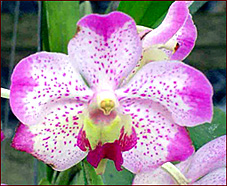
|
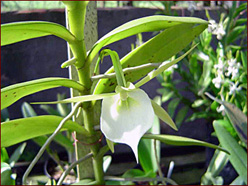 |
|
ON:
How many plants do you have nowadays, approximately?
Nowadays, eight years ago, I have, between seedlings, cuttings scions and adult plants, at about 6.000 in cultivation. |
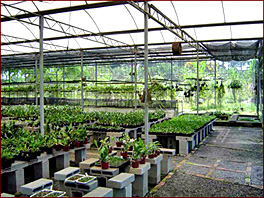 |
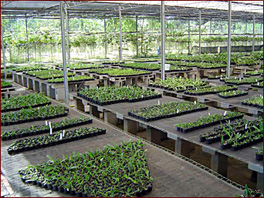 |
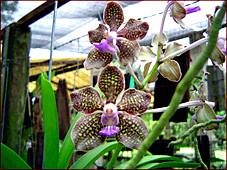
|
ON:
Which species do you have more? Which one is your favorite?
Hybrids of Cattleya, Brassavola and vandaceous. I do not have a favorite plant, if I could speak about a group, I would say that I prefer the vandaceous. |
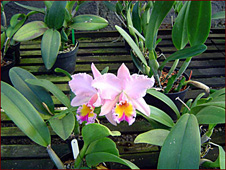 |
|
ON:
Why do you prefer hybrids?
I believe they are easier to cultivate. |
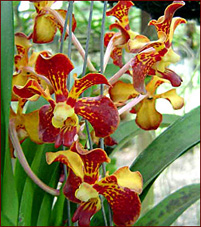 |
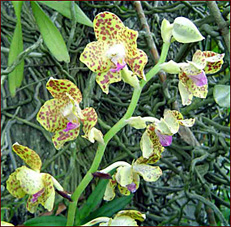
|
|
ON:
How long do you spend taking care of your orchids, daily?
I've never cared about the time, but I think I spend 6 hours taking care of them, on the average. |
|
ON:
Besides that first attraction, was there any influence (people or fact)
regarding your relationship with the orchids?
The spare time due to my retirement. |
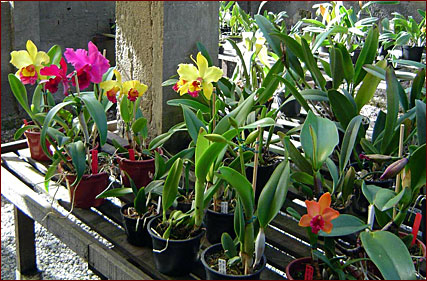 |
|
Which are the climatic conditions of the environment? Itaboraí
is located at the sea level, it is hot, the temperature falls down at
night and the humidity is above 60%. |
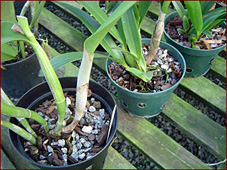 |
The
observation is everything because only our plants can say if they are
well or not, but the biggest difference to me is when I changed xaxim
(tree fern fiber) by pine bark mixed to rock crashed, 3 years ago. I took
time to know the exact proportion between the two elements (1/1) and,
today, the plants answer very well. Concerning my preferred group (vandaceous), I have been discovering, along the time, that what I have learnt, by many sources, do not always work well with me. I will give some examples: |
|
I
learnt that Vandaceous love strong light. It does not work like this.
Rhyncosthylis, for instance, are plants that prefer more shade with high humidity, the same to Paraphalaenopsis, Aerides and Vandopsis between other. Vanda teres, Arachnis, Renanthera and their hybrid can be cultivated direct under sun light since you use the winter to do the adaptation before the summer arrives however we can not forget to water and fertilize more, if possible. 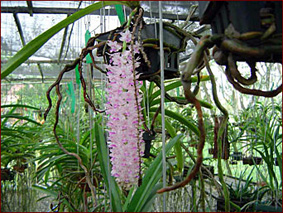 |
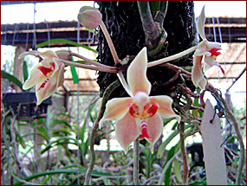 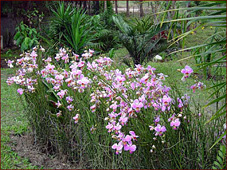
|
|
Once,
I noticed, in a green house in Thailand, an unusual way, to me, to cultivation
Vanda. There was a big lake covered with plastic covering 50% (I asked)
and concrete aisles above the water in a shape of rectangles. I don't
remember how long it was but it was narrow, at about 2m. The vandaceous
stayed hanged with their long roots almost touching the water.
|
|
When I came back, I immediately, tried to imitate this way to cultivate
Vanda. Unfortunately, it didn't work because the climate was not favorable
( humidity).
I forgot (or putting it another way, I didn't know) a basic rule about environmental humidity. It works taking off where the humidity percentage is big to where it is lesser. So, the percentage is equalized in every direction. The effect in my plants was curious and intriguing at the same time, until I discovered that rule. All plants had their roots, not towards the water but in direction of the humidity was |
|
going. The roots stayed almost parallel to the wood-baskets As soon as
I could, I dried up the water and put sand. Today, the roots are long
and perpendicular to the container.
|
|
ON: One said that orchidophilia is a soft manifestation
of madness. Have you done any "orchidophilic" insanity?
I believe that “madorchidist” would be the appropriate synonym for orchidist and an example of this happened to me. Once, my daughter, had two air tickets to go any place in the world and asked me if I wanted to travel with her and where I wanted to go. My answer was immediately: Thailand, land of the Vandaceous. I could go to Paris, New York or London, but I wanted to Bangkok, with nothing except for her English and, of course, the address of many greenhouses in that city. ON: Thank you. |
| Photos: Jorge Luiz Abreu da Silva |
|
Any
kind of reproduction (print, digital or anyone other) in any type of
material of this site - texts, layout, photos, images and others - is
strictly forbidden without previous written permission of the authors.
Any solicitation or information should be done by the e-mail:
bo@sergioaraujo.com
|